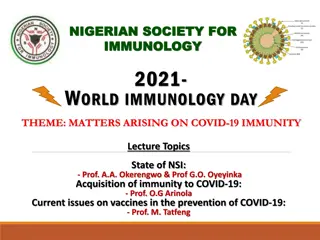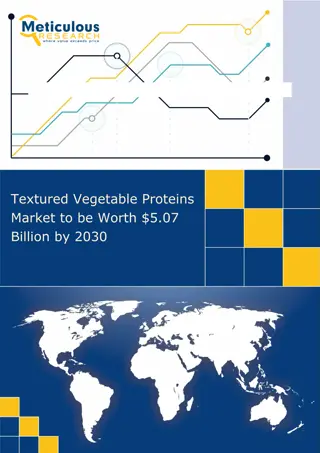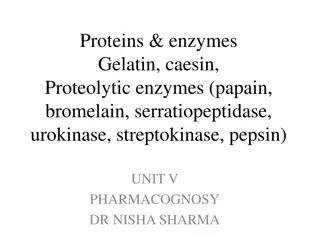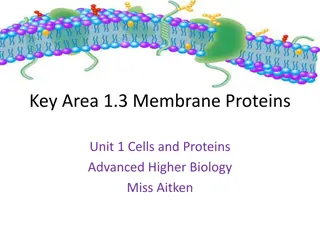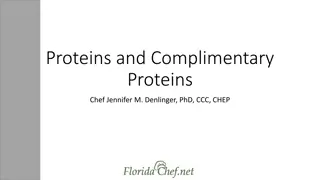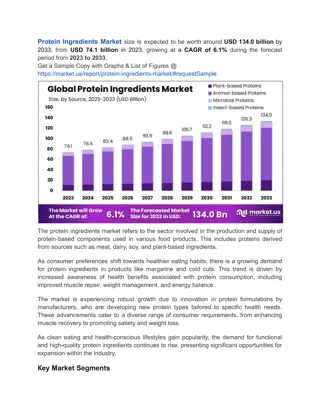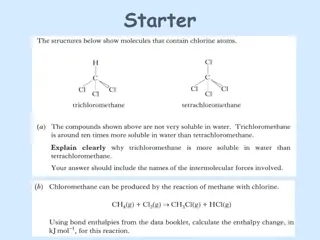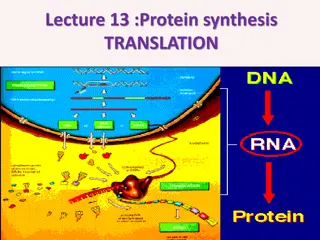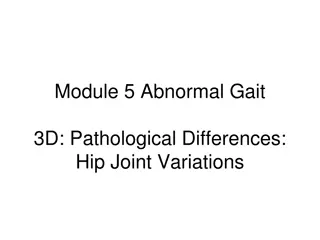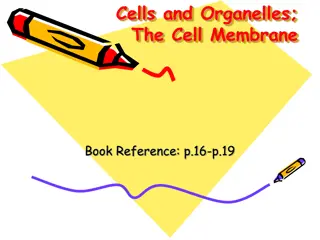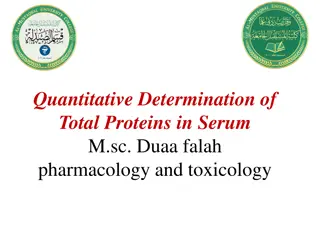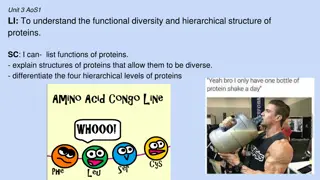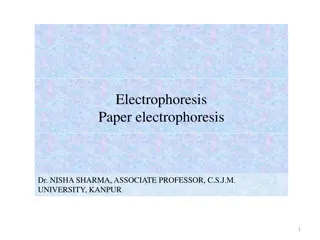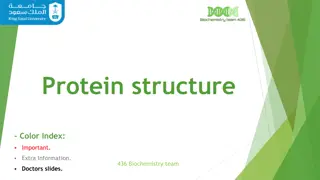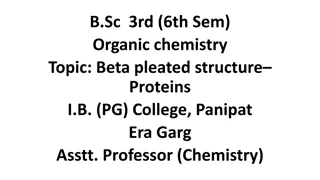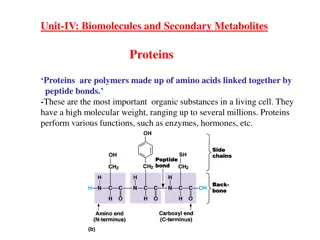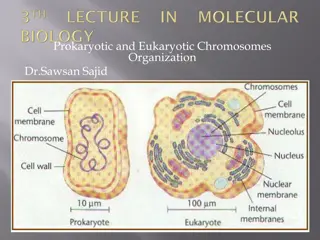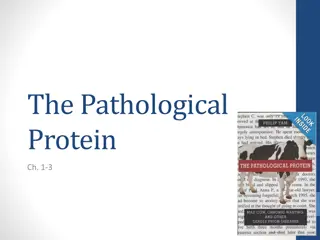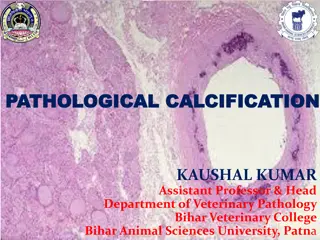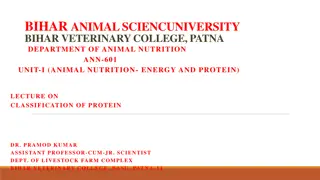Pathological Fractures
Pathological fractures occur in weakened bones due to underlying diseases or conditions, often manifesting with minimal trauma. Common causes include neoplastic lesions, infections, metabolic imbalances, and developmental disorders. Recognizing these fractures is crucial for timely intervention and
1 views • 20 slides
Understanding Plasma Proteins and Their Functions
Plasma proteins play a crucial role in various physiological functions such as controlling extracellular fluid distribution and transportation of hormones, vitamins, and other substances. The balance between protein synthesis and catabolism determines protein levels in the vascular compartment, affe
6 views • 23 slides
Enzymes are Proteins that act as Biological Catalyst
Enzymes, as proteins acting as biological catalysts, accelerate chemical reactions without being consumed. They have active sites where substrates bind, and their specificity can be lock-and-key or induced fit. Enzymes are named based on their function or the substrates they interact with. Enzyme sp
5 views • 20 slides
Insights on COVID-19 Immunity and Vaccines: NSI 2021 Lecture Highlights
Delve into the cutting-edge discussions from the Nigerian Society for Immunology's 2021 World Immunology Day event, featuring lectures on the state of NSI, acquisition of immunity to COVID-19, and current vaccine issues. Learn about the structural proteins of the SARS-CoV-2 virus, the importance of
4 views • 46 slides
Understanding Motor Proteins and Cytoskeletal Dynamics in Cell Biology
Motor proteins, such as myosin, kinesin, and dynein, utilize chemical energy to move along cellular tracks, influencing processes like muscle contraction, organelle movements, and cellular migration. With the ability to translocate using ATP hydrolysis, these proteins play crucial roles in various c
5 views • 14 slides
Textured Vegetable Proteins Market
Explore $5.07 billion Textured Vegetable Proteins Market: Get exclusive insights on key market trends, segments, geographical analysis, & competitive analysis!\n
1 views • 4 slides
Comprehensive Overview of Protein Digestion in the Gastrointestinal Tract
Understanding the process of protein digestion is crucial for optimal nutrient absorption and overall health. In this lecture series by Professor Shraddha Singh, delve into the composition of proteins, the role of enzymes in protein digestion, sites of absorption, molecular basis of protein transpor
0 views • 28 slides
Understanding Cell Membrane Transport: Diffusion and Facilitated Diffusion
Cell membrane transport plays a crucial role in maintaining cellular functions by regulating the movement of substances across the membrane. Diffusion, a passive transport process, allows molecules to move from areas of high concentration to low concentration without energy expenditure. Within diffu
1 views • 20 slides
Understanding the Relationship Between DNA and Protein Specificity
The relationship between an organism's DNA and protein specificity is intricate. DNA encodes the information for the sequence of amino acids in proteins, thereby determining their specificity. This process involves DNA directing the synthesis of specific RNA molecules, which are then translated into
0 views • 17 slides
Proteins, Enzymes, and Gelatin: A Comprehensive Overview
Proteins are essential for the structure and function of living cells, while enzymes play crucial roles in various biological processes. Gelatin, derived from bones, skins, and tendons of animals, is a valuable substance with unique properties. This content explores the significance of proteins, the
0 views • 10 slides
Understanding Membrane Proteins and Cell Membrane Permeability
Cell membranes consist of phospholipid bilayers with embedded proteins, including integral and peripheral proteins. Integral proteins span the membrane, while peripheral proteins interact with the surface. Only non-polar molecules can pass through the membrane directly, while charged ions, polar mol
0 views • 30 slides
Understanding Fractures: Traumatic vs. Pathological and Modeling Options
Defining the distinction between traumatic and pathological fractures, exploring the relationship between non-traumatic fractures and underlying bone pathologies, and discussing modeling options for classifying fractures. Stress fractures, insufficiency fractures, and the causes of pathological frac
2 views • 8 slides
Understanding Proteins: Alternatives and Complementary Choices
Explore the world of proteins with a focus on alternatives to meat-based meals and the concept of complementary proteins. Discover different sources of protein, understand the difference between complete and incomplete proteins, and learn how to combine foods to ensure you're meeting all essential a
0 views • 9 slides
Understanding Pathological Pigmentation: Causes and Effects
Pathological pigmentation involves the abnormal deposition of pigments in the body. It can be classified as exogenous or endogenous, with various sources and types of pigments. Melanin, one of the endogenous pigments, plays a crucial role in determining tissue color and can have protective functions
5 views • 23 slides
Understanding the Structure and Role of Amino Acids in Proteins
Amino acids are building blocks of proteins, with distinct structures and properties. There are 20 common amino acids found in mammalian proteins, each with a carboxyl group, an amino group, and a unique side chain. The side chains determine the role of an amino acid in a protein, classified as nonp
8 views • 11 slides
Health-Conscious Consumers Boost Demand for Functional Protein Ingredients
Protein Ingredients Market; By Product Type (Microbe-Based Proteins, Animal Proteins, Plant Proteins, and Insect Proteins); By Application (Infant Formulations, Animal Feed, Food & Beverages); By Region and Companies - Industry Segment Outlook, Marke
0 views • 4 slides
Understanding Plasma Proteins in Biochemistry Lectures
This informative content discusses the types, functions, and measurement of plasma proteins in biochemistry. It covers the importance of identifying various plasma proteins, their roles in disease diagnosis, and the interpretation of electrophoretic patterns. The lecture overview provides insights i
0 views • 30 slides
Understanding Proteins: Functions, Structure, and Breakdown
Explore the world of proteins, from their essential functions in living organisms to the chemistry of amino acids that form them. Learn how proteins are structured, the significance of amide links, and how they are broken down through hydrolysis. Delve into the importance of essential amino acids an
0 views • 17 slides
Understanding Amino Acids, Peptides, and Proteins in Organic Chemistry
Amino acids, peptides, and proteins are essential components in biological processes. Proteins are polymers made up of amino acid units linked by peptide bonds, while peptides are important in various biological functions. The structure and classification of amino acids play a vital role in the stru
0 views • 15 slides
Understanding Allergies to Animals and Living Organisms
Allergies to animals and living organisms are a result of specific immune processes triggered by allergenic substances like proteins and peptides. This allergic response can be caused by various animal proteins such as dog allergens Can f.1, Can f.2, and Can f.3, and cat allergen Fel d1. The represe
1 views • 10 slides
Addressing Pathological Conditions in Local Churches
Pathological conditions affecting local churches such as "Ethnic-itis," "Ghost town," and "People blindness" are discussed along with their symptoms and remedies. Solutions include transitioning to reflect the neighborhood, using circuit-riding pastors in rural churches, and celebrating cultural dif
1 views • 20 slides
Understanding Protein Synthesis and Translation Process
Proteins play a crucial role in various body structures and functions. The process of translation, as per the central dogma, involves converting genetic information from DNA to functional proteins through transcription and translation. This process includes initiation, elongation, and termination st
1 views • 25 slides
Pathological Differences in Hip Joint Variations: Abnormal Gait Analysis
Understanding pathological gait variations related to hip joint differences is crucial in gait analysis. Excessive sagittal, coronal, and transverse plane motions impact stance and swing phases, leading to deviations in gait patterns. Excess flexion, limited flexion, past retraction, excess adductio
0 views • 13 slides
Understanding Cell Membrane Structure and Proteins
Exploring the basic structure of membranes, the distribution of proteins within the membrane, intrinsic vs. extrinsic proteins, the fluid mosaic model, phospholipids forming the bilayer, the role of hydrophilic and hydrophobic parts in phospholipids, polysaccharides, and the differences between glyc
0 views • 18 slides
Clinical and Pathological Staging Cases in Oncology
This collection highlights clinical and pathological staging cases in oncology, covering scenarios from colon, lung, bladder, and kidney cancer. Each case presents detailed information on tumor characteristics, lymph node involvement, metastasis status, and clinical stages. Images accompany the desc
0 views • 9 slides
Understanding Quantitative Determination of Total Proteins in Serum
Serum total protein testing is essential for measuring the total protein content in blood, consisting of albumin and globulins. This test evaluates body health by assessing the levels of these vital proteins, aiding in diagnosing various health conditions. Learn about the significance of total prote
0 views • 15 slides
Qualitative Tests of Proteins & Amino Acids: Overview and Analysis
In this lab, you will delve into the qualitative tests for proteins and amino acids, understanding their structures, classifications, and importance in food and human nutrition. The tests include solubility tests and identification tests for both amino acids and proteins, revealing their presence an
0 views • 13 slides
Qualitative Tests of Proteins & Amino Acids - Lab Analysis Overview
This lab analysis covers qualitative tests for proteins and amino acids, including solubility tests and identification tests for amino acids and proteins. Specific tests like Ninhydrin test for -L amino acids, Xanthoproteic test for aromatic amino acids, and lead sulfite test for sulfhydryl group de
0 views • 13 slides
Understanding Protein Structure and Function Diversity
Proteins, composed of amino acids connected by peptide bonds, are crucial in all living organisms. They exhibit a wide range of functions and structural diversity. The hierarchical levels of proteins include primary, secondary, tertiary, and quaternary structures, each vital for proper protein funct
0 views • 12 slides
Understanding Paper Electrophoresis in Biochemistry Research
Paper electrophoresis is a powerful technique used in biochemistry to separate charged particles like proteins based on their migration along a filter paper strip. This method, conducted by Dr. Nisha Sharma, an Associate Professor at C.S.J.M. University in Kanpur, involves applying samples to the pa
0 views • 17 slides
Understanding Protein Structure and Function in Biochemistry
Proteins play vital roles in the body as large, complex molecules made up of amino acids. Understanding peptide bonding, levels of protein structure, and forces stabilizing proteins is crucial. Explore how protein misfolding can lead to diseases like Alzheimer's. Learn about the primary structure an
0 views • 26 slides
Understanding Beta Pleated Sheet Structure in Proteins
Beta pleated sheet structure is a secondary structure found in proteins where peptide chains lie side by side to form a flat sheet held together by hydrogen bonds. Proteins like keratin and fibroin exhibit this structure, while denaturation can alter the secondary and tertiary structures of proteins
0 views • 9 slides
Understanding Proteins: Structure and Function
Proteins are vital organic compounds composed of amino acids linked by peptide bonds. They serve various functions in cells, such as enzymes and hormones. Amino acids are the building blocks of proteins, with 20 different types forming all proteins on Earth. Proteins have four levels of structure -
0 views • 12 slides
Understanding Prokaryotic and Eukaryotic Chromosome Organization
Chromosomes are vital structures in cells, holding genetic material. Prokaryotic cells have a nucleoid containing DNA while eukaryotic cells have DNA enclosed in a nucleus. Proteins like H-NS, HU, FIS, and IHF play crucial roles in maintaining chromosome structure and gene expression. Unlike eukaryo
0 views • 20 slides
Unveiling the Mysteries of Pathological Proteins
The Pathological Protein delves into the intriguing case of Stephen Churchill, a young man whose sudden decline and tragic death spark questions about his mysterious neurological condition. As the investigation unfolds, more puzzling cases emerge, shedding light on the enigmatic world of neurodegene
0 views • 21 slides
Understanding Pathological Calcification in Veterinary Pathology
Pathological calcification is the abnormal deposition of calcium salts in soft tissues, with two forms - dystrophic and metastatic calcification. Dystrophic calcification occurs in dying tissues, while metastatic calcification reflects a derangement in calcium metabolism. Dystrophic calcification ca
0 views • 11 slides
Understanding Nutritional Requirements for a Balanced Diet
Nutrition is essential for energy production, growth, and body building. Nutrients like carbohydrates, fats, proteins, vitamins, and minerals play crucial roles. Carbohydrates provide energy, proteins are vital for body building, and a balanced diet is necessary for healthy growth. Animal and plant
0 views • 13 slides
Classification of Proteins in Animal Nutrition: Simple Proteins vs. Conjugated Proteins
Proteins in animal nutrition are classified into two main groups: simple proteins and conjugated proteins. Simple proteins can be further divided into fibrous and globular proteins based on their shape, solubility, and chemical composition. Fibrous proteins, such as collagens, elastin, and keratins,
0 views • 18 slides
Understanding Biuret Test for Protein Detection
The Biuret Test is a method used to detect the presence of proteins by identifying peptide bonds, which form the basis of protein structure. By utilizing a specific Biuret reagent, proteins can be quantitatively analyzed based on the color change observed. The test relies on the reaction between cop
0 views • 7 slides
Understanding Pathological Gambling: Diagnosis and Epidemiology
Pathological gambling, characterized by the inability to resist the urge to gamble despite severe consequences, is a progressively worsening disorder. This text discusses the diagnostic criteria for pathological gambling, its positive diagnosis according to DSM-IV-TR, and epidemiological data on the
0 views • 23 slides



